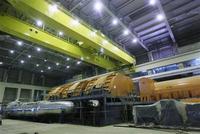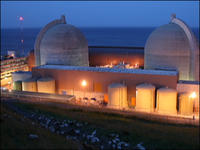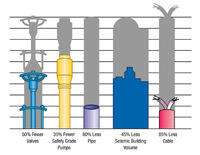-
U.S. industrial processes vulnerable to Stuxnet-like attack

Cyber security experts recently warned that U.S. manufacturing plants and critical infrastructure were vulnerable to a Stuxnet-like attack; industrial plants, transportation systems, electrical grids, and even nuclear plants could be crippled by new cyber weapons that target specialized control core processes; concern has spread after the Stuxnet virus targeted these systems and created physical damage; experts have likened Stuxnet to “the arrival of an F-35 into a World War I battlefield”
-
-
NRC: Not all equipment failures at U.S. nuclear plants are reported
Companies that operate U.S. nuclear power plants are not reporting some equipment defects that could create safety risks, according to a new report; the Nuclear Regulatory Commission’s (NRC) inspectors found at least twenty-four instances where possible equipment defects were identified but not reported to the agency from December 2009 through September 2010; the NRC inspector general also raised questions in the report about the agency’s oversight, saying reporting guidelines for the nuclear industry are “contradictory and unclear”; unless the NRC takes steps to improve its reporting guidelines, “the margin of safety for operating reactors could be reduced” the report said
-
-
Nuclear countries glean lessons from Japan's disaster

Japan’s effort to contain the escalating nuclear disaster reveals a series of missteps, bad luck, and desperate improvisation; what also emerges is a country that has begun to question some of its oldest values: Japanese have long revered the country’s bureaucratic competence, especially when it is contrasted with its political dysfunction; Japan has also proudly often chosen to go its own way and turn down outside assistance; other countries relying on nuclear power generation are trying to see whether the Japanese disaster holds lessons for them
-
-
Indian Point 50-mile evacuation plan unrealistic
Located only thirty-five miles north of New York City, the most populous area in the United States, is the Indian Point nuclear reactor; safety officials are questioning the wisdom of operating a plant so close to New York City; a fifty mile evacuation radius around the plant would affect nearly twenty million people and some say evacuating that many people on short notice is a “fantasy”; NRC is currently conducting a thorough safety review of U.S. nuclear plants and the Indian Point reactor is one of seventeen under scrutiny; New York Governor Andrew Cuomo recently called for the plant to be shut down
-
-
Businesses cannot defend against cyber attacks, expert says
In a recent testimony before Congress, a cyber security expert warned that the private sector in the United States has proven unable to defend the nation’s critical cyber infrastructure from attack; businesses own 85 percent of critical infrastructure and they have not invested in the skills or technology to secure it from cyber attack leaving the electrical grid, financial services, and other key elements vulnerable; foreign intelligence agencies, organized gangs, and corporate spies have successfully infiltrated banks, multinational corporations, and even government websites and stolen sensitive data; cyber security experts urged for greater government regulation to secure U.S. networks
-
-
Alstom acquires CA company, seeks to enter U.S. smart grid market
French electrical grid manufacturer Alstom recently acquired Utility Integration Solutions, Inc. (UISOL) in its efforts to expand its smart grid control room capabilities and enter the U.S. market; UISOL specializes in demand response management systems, which are critical to the operation of smart grids; analysts believe that this could put Alstom in position to become an integrated systems provider for smart grids in the United States on par with ABB, Siemens, and General Electric
-
-
Marines complete largest solar power system yet

The U.S. Marine Corps recently completed construction of a 1.4 megawatt solar electric system at Marine Corps Base Camp Pendleton; the solar installation is currently the largest system installed to date on a Marine base; the new system is expected to generate 2,400 megawatts each year and power roughly 400 homes; it will save the base $336,000 in energy costs annually; on Monday, the Corps announced a comprehensive strategy to harness solar energy in Afghanistan to reduce fuel consumption and save lives
-
-
California schools seismically unsafe, lack funding for retrofits
Hundreds of thousands of students across California are at risk, as school districts have not retrofitted aging concrete buildings that are susceptible to collapse; the state has identified dozens of structures at schools that are at risk of collapsing in a strong earthquake, but most are still in use and have no plans for repairs; engineers are particularly concerned about old concrete school buildings that were erected before 1976; these structures are constructed with “non-ductile” concrete, a type of material that did not hold up well in the recent earthquake in New Zealand; cash-strapped school districts are hesitant to begin long and expensive retrofitting projects even with state help
-
-
After EPA fine, mining company building $200 million water treatment plant

America’s largest underground coal mining company, Consol Energy, is constructing a $200 million water treatment plant in West Virginia, after being fined $5.5 million by the Environmental Protection Agency (EPA); in 2009 discharge from Consol’s mining operation caused a toxic golden algae bloom that killed aquatic life along thirty miles of Dunkard Creek; the advanced waste water treatment plant will be the largest facility in Appalachia; the plant will be capable of treating 3,500 gallons of water per minute and will remove more than forty-three tons of dissolved solids, including eleven million pounds of chloride
-
-
Drought-prone pasts may foretell New York's and Atlanta's futures

By fall 2007, during the second year of a three-year drought, Atlanta had roughly three months’ supply of water remaining while Athens, Georgia was down to approximately fifty days; another drought dramatically lowered New York City reservoirs to 33 percent of capacity in 1981; droughts in those cities and their surrounding regions were typically longer and more frequent centuries ago than they were for most of the twentieth century; a return to historic climate patterns would bring more frequent and prolonged droughts
-
-
U.S. reconsiders nuclear plant sites amid safety review

Following the nuclear crisis that occurred in Japan as a result of a massive earthquake and tsunami, the United States is undergoing a thorough safety review of existing plants that may affect where new plants are located; President Obama ordered the Nuclear Regulatory Commission (NRC) to conduct a comprehensive safety review of all nuclear plants in the United States; observers are particularly concerned with the Indian Point nuclear power station located forty miles north of New York City; if an accident were to occur, up to twenty million people, including eight million in New York City, would have to be evacuated
-
-
Lodi, CA considers privatizing $36 million water plant
The city of Lodi, California is in the midst of building a new $36 million water treatment plant, and is considering privatizing the facility; the new plant will open in 2012 and provide the city with one-third of its drinking water; Lodi is in a tight financial situation and is considering methods to reduce costs like privatizing the new treatment plant; the treatment facility is expected to cost $1.8 million to operate annually with an additional $1 million for payroll; Lodi residents have proposed that the city hire a private company to save money on payroll
-
-
Politics stalls $250 million water plant in North Vegas
A $250 million wastewater treatment plant in North Las Vegas suffered a major setback after county commissioners denied the plant’s request to use county land; the city had planned to route treated water through unincorporated county territory and pay the county $50,000 a year, but the county voted six to one against the plan; county commissioners say that the city has not been cooperative; commissioners were particularly upset about the city’s lucrative deal with Nellis Air Force Base that would take $1.25 million in revenues from the county each year; the plant has been under construction for years and needed the use of a Clark County pipeline to operate
-
-
Sector Report for Monday, 21 March 2011: Infrastructure protection
This report contains the following stories.
Plus 2 additional stories
-
-
New reactor design lessens risks

One of the major vulnerabilities of the four Japanese reactors which failed as a result of the combined force of the earthquake and tsunami, was that they relied on active cooling systems that require electricity; if there is a power outage, and if diesel back-up generators stop working, water stops flowing into the reactor pool to keep the uranium rods cool; newer reactor design relies on a passive cooling system: water is suspended over the reactor housing, and if pressure within the system drops, this allows the water to fall into the reactor area, submerging it in enough water to keep it cool
-
More headlines
The long view
Falling Space Debris: How High Is the Risk I'll Get Hit?
An International Space Station battery fell back to Earth and, luckily, splashed down harmlessly in the Atlantic. Should we have worried? Space debris reenters our atmosphere every week.
Using Drone Swarms to Fight Forest Fires
Forest fires are becoming increasingly catastrophic across the world, accelerated by climate change. Researchers are using multiple swarms of drones to tackle natural disasters like forest fires.
Strengthening the Grid’s ‘Backbone’ with Hydropower
Argonne-led studies investigate how hydropower could help add more clean energy to the grid, how it generates value as grids add more renewable energy, and how liner technology can improve hydropower efficiency.
LNG Exports Have Had No Impact on Domestic Energy Costs: Analysis
U.S. liquified natural gas (LNG) exports have not had any sustained and significant direct impact on U.S. natural gas prices and have, in fact, spurred production and productivity gains, which contribute to downward pressure on domestic prices.
